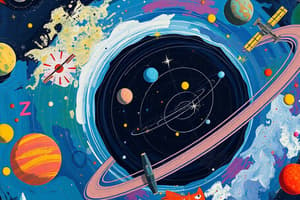Podcast
Questions and Answers
What do constellations represent?
What do constellations represent?
- Patterns of the sun's movement
- Shapes of animals
- Groupings of stars that form recognizable shapes (correct)
- Cycles of the moon
What is the primary reason for the changing of the seasons?
What is the primary reason for the changing of the seasons?
- The movement of the moon
- The sun's path across the sky (correct)
- The rotation of the stars
- The Earth's rotation on its axis
What is the significance of the stars in navigation?
What is the significance of the stars in navigation?
- They signal the changing of the seasons
- They mark the cardinal directions and provide information about the time of night (correct)
- They indicate the direction of the sun
- They predict the weather patterns
What is the main function of the sun in our daily lives?
What is the main function of the sun in our daily lives?
What is the result of the Earth's rotation on its axis?
What is the result of the Earth's rotation on its axis?
Flashcards are hidden until you start studying
Study Notes
Day and Night Sky Patterns: Phases of the Moon, Stars, and the Sun
The sky is a vast canvas of ever-changing patterns, with the phases of the moon, stars, and the sun being the most captivating features. These celestial bodies move in their own orbits and rotations, creating a mesmerizing display for the observer. In this article, we will delve into the intricate details of these patterns and how they shape our night sky.
Phases of the Moon
The moon is a constant presence in the night sky, and its phases change over the course of a lunar cycle. The moon's phases are caused by the alignment of the moon, Earth, and the sun. During a full moon, the moon is on the opposite side of the Earth from the sun, and its entire face is illuminated by the sun's light. As the moon moves along its orbit, the sun's light casts different amounts of light on the moon's face, resulting in the different phases we see. The phases of the moon include the new moon, crescent moon, quarter moon, gibbous moon, and full moon. Each phase has its unique charm and significance, and many cultures have myths and folktales associated with them.
Stars
Stars are the twinkling dots that fill the night sky. They appear to move across the sky due to Earth's rotation on its axis. As the Earth revolves around the sun, the position of the stars changes, creating patterns that are visible to the naked eye. These patterns are known as constellations, and they have been studied and documented by cultures around the world for thousands of years. Constellations are groupings of stars that form recognizable shapes, and they often have mythological or cultural significance. For example, the constellation Orion represents a hunter, and the constellation Ursa Major represents a bear. Stars can also be used to navigate, as they mark the cardinal directions and provide information about the time of night.
The Sun
The sun is the most prominent object in the sky during the day, and it plays a crucial role in our daily lives. The sun's position in the sky changes throughout the day, and as the Earth rotates on its axis, different parts of the sky are illuminated by the sun. The sun's path across the sky also changes as the seasons progress, with the sun appearing higher in the sky during summer and lower in the sky during winter. This change in the sun's position is what causes the changing of the seasons. The sun's path also affects the length of the day and the amount of daylight we receive throughout the year.
In conclusion, the day and night sky patterns are a fascinating subject that offers a glimpse into the intricacies of our universe. By understanding the phases of the moon, the stars, and the sun, we can appreciate the beauty and complexity of the celestial bodies that surround us.
Studying That Suits You
Use AI to generate personalized quizzes and flashcards to suit your learning preferences.




